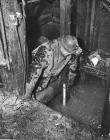27
Leyner Drill, Silver Miller MineOver the years the Leyner drill was made lighter but was still a two man job to run, particularly in confined areas. The bar was tightened up by means of a screw jack to avoid movement .
28
Bar and Arm Drilling1915
Cobalt Mining Camp, Town of Cobalt and Coleman Township, Ontario, Canada

29
Bar and Arm DrillingThe bar and arm drill eventually became light enough that it could be set up by one man and operated successfully. The drill was forced forward against the rock by means of a screw handle . In later models this was replaced by a motorized feed. Water was added at the drill for dust suppression.
31
Stoper DrillingAs time progressed stoper drills continued to be used in mining. The drills were relatively light, easily handled and convenient for many jobs that required a hole in the rock. Drill steels were also lighter and bits were made of tungsten carbide that did not require constant sharpening. Water was used to stop the dust that had plagued the miners for years.
33
Ore Chute and CarSilver ore that had been mined in the stopes was passed out to the haulage crews through chutes. These chutes had gates that controlled the flow of the ore into the cars. Rocks sometimes got stuck under the gate causing a “run of muck” onto the track and sometimes burying the muck car. This usually meant a lot of shoveling by the haulage crew to clean up. The rocks sometime got stuck before coming out of the chute which meant “barring” the chute with long steel bars and sometimes using explosives to break up the blockage. This had to be done very carefully to avoid damage to the chute structure.
34
Mine Cars and Locomotive1925
Cobalt Mining Camp, Town of Cobalt and Coleman Township, Ontario, Canada

35
Mine Cars and LocomotiveIn the bigger mines, cars were pulled in trains by battery powered locomotives or ‘locos’. The batteries to power these locos were lead acid and required recharging after an eight hour shift or even more often if the usage had been heavy. The mine cars weighed about 500 lbs and could hold between half a ton to a ton depending on size. A train of six cars could weigh as much as seven or eight tons. The track gauge was usually eighteen inches and the rail weighed twenty pounds to the yard. The rail was spiked down to wooden ties and maintained by a trackman in the larger mines or by the loco operators in the smaller mines.
36
Main Underground Haulage1920
Cobalt Mining Camp, Town of Cobalt and Coleman Township, Ontario, Canada

37
Main Underground HaulageThe larger mines had main underground haulage areas with switches and sidings just like a surface railroad. This was particularly true in station areas near the shafts when there was room for mine supplies such as timber, drill steel, explosives, full and empty mine cars and pipe. These areas in the larger mines were also fitted with electric light to increase the visibility.
38
Checking Shaft Water Levels1925
Cobalt Mining Camp, Town of Cobalt and Coleman Township, Ontario, Canada

39
Checking Shaft Water LevelsWater was an ongoing problem and potential source of danger in an underground mine. The bottom of the shaft was usually the lowest point in the mine and water always flowed to this point from all areas of the mine. The water level had to be checked daily or more often especially in the springtime or after heavy rain as water ran into the mine through the mined out areas. Pumps sent the water to surface as necessary.
40
Checking Water Levels1925
Cobalt Mining Camp, Town of Cobalt and Coleman Township, Ontario, Canada


